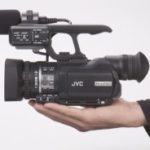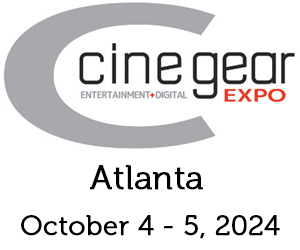
REVIEWS – HD Palmcorders AVCHD
Posted on Mar 29, 2010 by Alex Fice
There are times when you can’t use a professional HD camera, times when you need something smaller, or more dispensable, perhaps to go on a magic arm on a bike, or into a stunt car. The latest batch of AVCHD camcorders from the major manufacturers promise tiny, light and vibration resistant HD capture – their only moving parts are in the lens assembly. HD User has pulled together the latest offerings from each of the Japanese big four – JVC, Sony, Canon and Panasonic – to see what they offer the professional.
AVCHD is toted as the replacement for HDV. It’s based on the much more advanced H.264 compression scheme – as used on shiny, 21st Century, Blu-ray discs – instead of HDV’s MPEG-2, which is used on dull old DVDs from way back in the 20th Century. That should mean that, at a given bitrate, you should get better pictures from AVCHD than from HDV or, equally, you should need fewer bits for similar image quality. The problem is that squeezing the AVCHD CODEC onto a silicon chip is much, much harder than the HDV CODEC, which has tended to mean that the images from new AVCHD cameras have been worse than those from five year old HDV cameras. Embarrassing, to say the least. Manufacturers have responded by upping the bitrate to the point that two of these new camcorders now offer 24Mbps – much the same as HDV – so that should look great, right?
Canon Legria HF20
The first of these 24Mbps cameras is the Legria HF20 from Canon. Undoubtedly the best looking of the four, with its shiny black finish and flush fit battery, it’s also the only one that has internal FLASH storage – 32GB – giving you about three hours of recording at the best quality before you have to slot in an SDHC card. There’s a single 1920×1080 CMOS sensor (1/4in), which can capture either 1080/50i or 1080/25pf – Canon’s implementation of progressive. All very nice. Also nice is the user interface which you navigate with a tiny joystick on the edge of the flip out LCD. The menus are the best looking and most intuitive of all the cameras on test and the on-screen data is also the clearest of the bunch. Just when you thought it couldn’t get any better, Canon have included their Instant AF autofocus system, nicked from their pro and semi-pro cameras. All the other cameras have to analyse the data coming from the image sensor to determine focus. The Canon does this too, but supplements the data with a special sensor on the front of the camera. As a result, the HF20 snaps into focus faster and more accurately than any other HD palm camcorder. There is an input for an external microphone and a jack for headphones, so you could pimp the Canon up to be a useful production tool.
It isn’t all roses in the Canon camp though. Presumably to protect your data, the camera insists that you connect the mains adapter before it will allow you to download footage to your computer. That’s fine, if you have mains, but what if you’re in the field with a laptop? Secondly, in low light, the Canon uses the least software noise reduction of any of the four cameras. Whilst this means that you retain detail in the images, the chroma noise is really distracting. It’s the most expensive, manual focus is not straightforward using a joystick and there is no zebra.
JVC GZ-HD300EK
The second 24Mbps camera is the JVC GZ-HD300REK. This is the smallest of the four, even though it has an internal 60GB hard drive along with a Micro SDHC card slot. The review unit was a dark, metallic red that reminded me of a 1970s Ford Capri (in a good way), and it played the cheeriest tune when you turn it on. Big brownie points there. It also has a roughly ¼in CMOS 1920×1080 sensor though this time it’s limited to interlaced only, there is no progressive option. Annoyingly, all the manufacturers have different marketing terms for their bitrates – whilst Canon’s 24Mbps offering is called MXP, JVC have dubbed theirs UXP. The Sony and the Panasonic are limited to 16Mbps and 17Mbps respectively, though the Sony standard is called FH and the Panasonic HA1920. If they’ve all signed up to the same CODEC standard, can’t they agree on a common naming convention for the quality settings? Please?
The JVC’s LCD has the lowest resolution of the four camcorders and quite the worst user interface I’ve seen in a while. Whilst the menus are reasonably clear they are navigated with a series of buttons at the bottom of the screen and a linear touch pad – called the Laser Touch control – that runs up the side of the screen. This has four blue LEDs underneath it to indicate its operation and it looks very groovy. However, sliding your finger up and down the control and confirming operations on the buttons is very slow and awkward. I’m sure you would get used to it, but in comparison to the Canon, Sony and Panny it was horrid.
The JVC does score over its competition in several ways, however. The lens has the largest zoom range of any of them – 20x, meaning at the long end you have what would be an 828mm lens on 35mm film. Wow! There is coloured peaking for manual focus assist, though you still have to focus using the Laser Touch control. It’s a small point, but the JVC is the only camera in the test with the tripod bush on the lens axis. The others are all offset to some degree, giving you slightly odd pans.
Unfortunately, the basic nature of the JVC means there is no external microphone input though, like the Canon, the built in mics are on the front of the unit so work surprisingly well.
Sony HDR-CX11E
The Sony HDR-CX11E is similar in design to the pretty Canon and has a solid, professional feel to the controls. This time there’s a 1/3in CMOS sensor recording true 1920x1080i – again, no progressive available – at a maximum 16Mbps. The camera uses Sony’s excellent touch screen user interface – one of its best tricks is the ability to focus on, and/or expose for part of the image simply by tapping on it. You can pull focus between two actors, for instance, by just prodding them on the screen. The downside of the touch screen approach, however, is that you get fingerprints all over the screen, which can make it difficult to see in bright sunlight. This, however is a small quibble, easily solved by keeping a couple of screen wipes on you, and keeping away from the jam doughnuts, especially when you consider that this camera is the only one in the test with zebra (70% or 100%) and a dedicated rotary control which can be used for focus or exposure.
The HDR-CX11E records AVCHD data onto Sony’s Memory Stick PRO Duo. Although a Sony standard, there are several second sources, which keeps the prices honest but, unlike SDHC, you aren’t likely to have some knocking about so you’ll need to include some in your budget.
A slight annoyance is Sony’s dock, which is the only way to connect a USB cable to the camera – there is no USB connector on the camera itself. That’s fine if you are at your desk, but means you have to drag the dock and cable around with you if you are on the road. Another annoyance is the lack of mic input, a flaw shared with the final camera in our group, the Panasonic HDC-SD200.
Panasonic HDC-SD200
Panasonic have long sought to distance themselves from the competition by sticking to using three sensors – originally CCDs but now CMOS (dubbed 3MOS – donchya just love marketing?) giving you three, 1/4in full 1920×1080 sensors (10 megapixels for stills), just like a pro video camera, but sadly interlaced only and compressed to 17Mbps.
The camera itself is very small, light with good feeling controls, though surprisingly few of them. That’s because Panasonic have followed their rival Sony’s lead and introduced a touch screen interface. What’s more, it’s better than Sony’s. The menu layout is particularly clear – they have separated the setup menu (a membrane key under the screen) from the image control menu which runs as a bar at the bottom of the touch screen. There is an implementation of the ‘touch to focus’ function, though the on-screen status display can be a little cluttered – somehow Panasonic’s fonts are just a bit too bold and clunky. You can turn most of the displays off, if they bother you. Most importantly, however, there is something about the surface of the LCD which doesn’t show the fingerprints as much as the Sony, so you can still see it on a sunny day. What’s more, the 2.7in screen even has a slightly higher resolution than the Sony. Nice.
The Panasonic has an interesting Intelligent Auto mode which automatically switches to the appropriate ‘scene mode’. So, for instance, if the camera detects a face, it will switch image parameters to favour skin tones. It works surprisingly well, as does the amazing optical image stabilisation – easily the best in this class.
Conclusion
So which of these four little palmcorders is the best? As you might expect, that isn’t an easy question to answer. Our favourite is undoubtedly the Canon. The combination of progressive scan and the high data rate meant it aced our favourite compression stress test – water bubbling under a sluice gate – which confuses the hell out of most compression algorithms. The autofocus response is truly outstanding, just as well as the Sony is the only cameras we could ever imagine using in manual focus, thanks to that dedicated rotary control. In our resolution tests the Canon and the Panasonic sit at the top of the class, just ahead of the Sony with the JVC trailing behind. In fact, taking into consideration colour reproduction, tonality and so on, the results are the same – Canon and Panasonic generate the best pictures with the Sony close behind. However, in low light the Sony really shines (pun intended), having the best compromise between detail sapping noise reduction and annoying noisy pictures. Sadly, the AVCHD compression engines still aren’t as good as HDV, though you have to be a pixel monkey to spot the difference with the higher data rate settings.
Although the Canon gets first place, it is currently the most expensive of the four, at about £800. However, it is brand new so that price is bound to drop – in fact it probably will have by the time you read this.
Second place, behind the Canon, goes to the Sony because it is outstanding value – it’s available on the street at about £550 against just over £700 for the Panasonic. That alone drives the Panasonic into third as it’s a very good camera, lacking only Sony’s manual control but gaining points for its implementation of the touch screen.
Looking dejectedly at its feet as it trails in last is the JVC. It has the worst image quality, worst user interface and lacks many of the features of the other three. It looks and feels much cheaper than the others, an impression doubled by the image quality, but the lowest price we could find for it is £630, nearly £100 more than the Sony. So, unless you want one to match your Capri we wouldn’t recommend it.






















